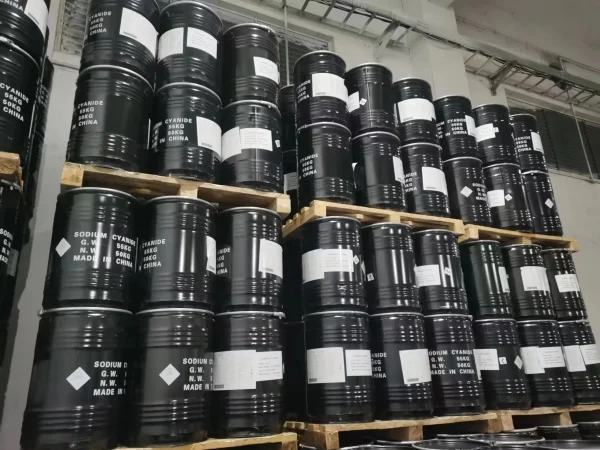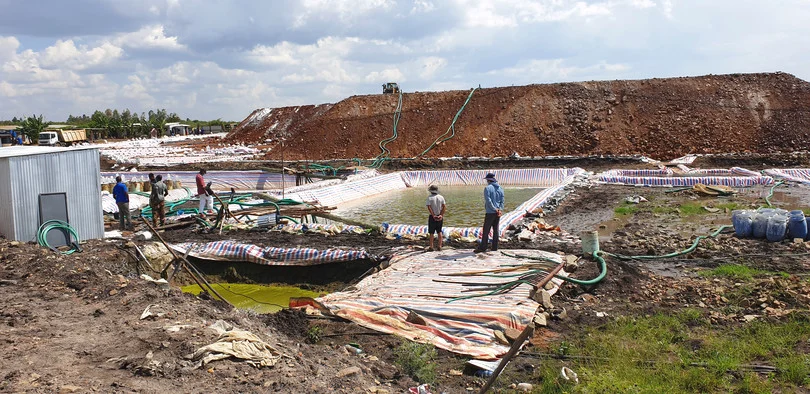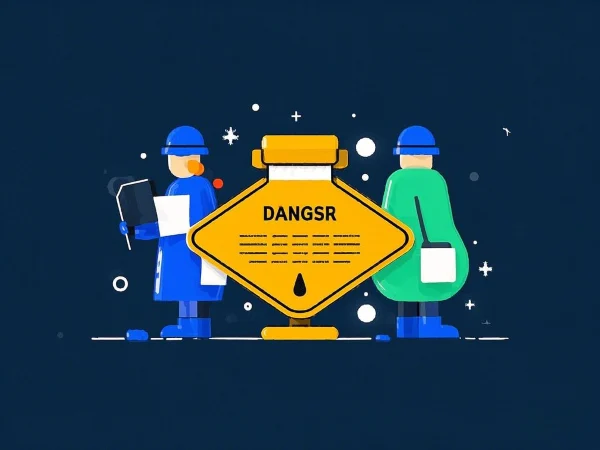Introduction

Cyanide sodium, a chemical compound notorious for its extreme toxicity, has been widely used in the Mining Industry for decades, particularly in gold extraction. Its ability to dissolve gold and other precious metals from ores has made it an indispensable tool for miners. However, the use of cyanide sodium has also raised significant concerns about safety, both for the workers involved and the environment. In this article, we will explore the question: Is it safe to use cyanide sodium in mining?
What is Sodium Cyanide?

Sodium cyanide is a chemical compound with the formula NaCN. It typically appears as a white crystalline solid, often in the form of pellets or powder. One of its most notable characteristics is its faint, bitter almond odor, which can act as a warning sign of its presence, though not everyone can detect this smell.
This compound is highly soluble in water, and in aqueous solutions, it hydrolyzes to produce hydrocyanic acid (HCN), a volatile and extremely toxic gas. Sodium cyanide is renowned for its potent toxicity; it can cause rapid and severe poisoning in humans and animals. Even a minute amount, when ingested, inhaled, or absorbed through the skin, can disrupt the body's normal physiological functions and lead to fatality. The mechanism behind its deadly effect lies in its ability to interfere with cellular respiration. Once inside the body, cyanide ions bind to cytochrome oxidase, an enzyme crucial for the final step of the electron transport chain in cells. By doing so, it blocks the transfer of electrons, preventing cells from using oxygen effectively, ultimately resulting in cell asphyxiation and tissue hypoxia.
Sodium cyanide is widely used in various industries. In metallurgy, especially in gold mining, it plays a central role. The cyanide leaching process, which involves using Sodium Cyanide solutions, is a common method to extract gold and other precious metals from ores. It forms stable complexes with gold, allowing the metal to be dissolved and separated from the surrounding rock. Additionally, it finds applications in electroplating, where it helps deposit a thin layer of metal onto surfaces, and in chemical synthesis, serving as a building block for the production of numerous organic and inorganic compounds, including pharmaceuticals, pesticides, and dyes. However, due to its extreme toxicity, its handling and use require the strictest safety precautions and regulatory compliance.
The Use of Sodium Cyanide in Mining

Mining Process
The use of sodium cyanide in mining, particularly in gold extraction, involves a series of carefully controlled processes. Firstly, the ore is typically crushed and ground to a fine powder to increase its surface area, facilitating better contact with the cyanide solution. This pulverized ore is then mixed with a dilute Sodium cyanide solution in large tanks or vats. The cyanide forms complexes with the gold present in the ore, allowing it to dissolve. This process, known as cyanidation or leaching, can take several hours to days, depending on the ore's characteristics.
After the leaching process, the gold-bearing solution is separated from the remaining solid waste, which is known as tailings. The gold is then recovered from the solution using methods such as carbon adsorption, where activated carbon attracts and binds the gold complexes. Alternatively, zinc precipitation can be employed, where zinc powder is added to the solution, causing the gold to precipitate out. The recovered gold is further purified through processes like smelting to obtain high-purity gold bars or other forms suitable for the market.
Advantages
One of the primary advantages of using sodium cyanide in mining is its high efficiency in gold extraction. It can dissolve gold even from low-grade ores, making it economically viable to mine deposits that would otherwise be unprofitable. Compared to some alternative methods, such as gravity separation or flotation, cyanidation often achieves significantly higher recovery rates, sometimes exceeding 90% of the gold present in the ore.
From an economic perspective, the cost-effectiveness of sodium cyanide is another significant factor. The relatively low cost of the chemical, combined with its ability to process large volumes of ore, contributes to the overall profitability of Mining Operations. It also allows for the exploitation of smaller and more dispersed gold deposits, expanding the potential sources of gold production.
Safety Concerns
Toxicity Risks
The extreme toxicity of sodium cyanide poses a significant threat to the health of miners. Inhalation or skin contact with even small amounts of cyanide can lead to severe poisoning. The symptoms can range from dizziness, headache, nausea, and weakness to rapid loss of consciousness and death. There have been numerous tragic incidents where miners, due to improper handling or accidental exposure, suffered fatal consequences. For example, in some illegal gold mining operations in remote areas, miners lacking proper safety equipment and training have inhaled cyanide gas, resulting in immediate incapacitation and, in many cases, death on the spot.
Environmental Impact
When sodium cyanide is used in mining, there is a substantial risk of environmental pollution. If not properly managed, cyanide can contaminate water bodies, leading to the death of aquatic life. Fish and other organisms are highly sensitive to cyanide, and even trace amounts can disrupt their respiratory systems and cause mass die-offs. Additionally, cyanide-contaminated water can seep into the soil, affecting soil fertility and potentially contaminating groundwater, which is a crucial source of drinking water for many communities. The long-term ecological consequences can be devastating, disrupting entire ecosystems and leading to a loss of biodiversity. For instance, in regions where cyanide-based gold mining has been prevalent, nearby rivers and lakes have seen a significant decline in fish populations, and the surrounding vegetation has also been negatively impacted due to soil degradation.
Safety Precautions and Regulations
Mining Company Practices
Mining companies that use sodium cyanide must implement stringent safety measures. Firstly, proper ventilation systems are crucial. In areas where cyanide is stored, handled, or used, such as ore processing plants and leaching facilities, adequate ventilation ensures that any potential buildup of hydrogen cyanide gas is minimized. This involves installing powerful exhaust fans and ducting to continuously draw out air and replace it with fresh air.
Personal protective equipment (PPE) is non-negotiable. Workers should be provided with and required to wear full-body protective suits made of chemically resistant materials to prevent skin contact. Respiratory protection, such as gas masks with appropriate filters capable of trapping cyanide vapors, is essential. Gloves and safety goggles also form part of the standard PPE ensemble.
Training programs are a cornerstone of safety. All employees involved in any aspect of cyanide handling must undergo comprehensive training. This includes learning about the chemical's properties, toxicity, and the correct procedures for its use. They should be trained in emergency response, such as how to administer first aid in case of cyanide poisoning and how to evacuate safely in the event of a spill or leak.
Regular equipment inspections and maintenance are vital. Tanks, pipes, valves, and other infrastructure used in the cyanide process must be checked frequently for signs of corrosion, leaks, or other damage. Any faulty equipment should be repaired or replaced immediately to prevent accidental releases.
Emergency response plans must be in place and regularly rehearsed. In the event of a cyanide spill or leak, there should be a clear protocol for evacuating workers, containing the spill, and initiating cleanup procedures. This includes having on-site emergency response teams equipped with the necessary tools and materials, such as absorbent pads, neutralizing agents, and decontamination showers.
Regulatory Standards
Both national and international regulatory bodies have established strict guidelines for the use of sodium cyanide in mining. These regulations cover every aspect of its lifecycle, from production to disposal.
In many countries, the production of sodium cyanide is limited to a few authorized facilities that must adhere to strict safety and environmental standards. These plants are subject to regular inspections by regulatory authorities to ensure compliance.
Transportation regulations mandate that cyanide shipments be clearly labeled as hazardous materials. Specialized containers and vehicles, equipped with safety features like spill containment systems and emergency response kits, are required. Drivers and transport personnel must have specific training and licenses to handle such dangerous cargo.
Storage facilities for sodium cyanide must meet stringent criteria. They should be located away from populated areas and water sources, with secure fencing, access controls, and monitoring systems. Storage buildings should be designed to prevent leaks and spills, with impermeable floors and secondary containment systems.
Regarding its use in mining, there are often limits on the concentration and quantity of cyanide that can be used. Mining companies must also submit detailed environmental impact assessments and management plans, which include measures to prevent and mitigate any potential cyanide releases.
International agreements and treaties, such as those related to transboundary pollution and hazardous waste management, further regulate the use of sodium cyanide. These ensure that countries work together to prevent the spread of cyanide pollution across borders and promote sustainable mining practices globally.
Conclusion
In conclusion, the use of sodium cyanide in mining is a complex issue that demands a delicate balance between Economic Benefits and safety concerns. While its toxicity and potential for environmental harm cannot be overlooked, when proper safety precautions are implemented by mining companies and strict regulatory standards are enforced, the risks associated with its use can be significantly mitigated.
Mining operations that utilize sodium cyanide must view safety as an integral part of their business model. By investing in state-of-the-art ventilation systems, providing comprehensive PPE, and conducting regular training and equipment maintenance, they can protect their workers from the immediate dangers of cyanide exposure. Additionally, adhering to regulatory guidelines regarding storage, transportation, and waste disposal helps safeguard the environment and surrounding communities.
It is also essential to note that ongoing research into alternative gold extraction methods and the development of more environmentally friendly technologies offer hope for a future where the mining industry can reduce its reliance on highly toxic chemicals like sodium cyanide. Until then, with continued vigilance and a commitment to safety, the use of sodium cyanide in mining can be managed in a way that minimizes harm and maximizes the economic benefits it provides.
- Random Content
- Hot content
- Hot review content
- Dithiophosphate 25S
- Shock Tube Detonator
- Cobalt Sulfate 98% Brown yellow or red crystal
- Ammonium Bisulfite 70% Solution
- Ethyl Methyl Carbonate (EMC) 99%
- Industrial/Food Grade 58/60 Fully/Semi Refined Slab Paraffin
- Copper(II)Chloride Dihydrate
- 1Discounted Sodium Cyanide (CAS: 143-33-9) for Mining - High Quality & Competitive Pricing
- 2Sodium Cyanide 98% CAS 143-33-9 gold dressing agent Essential for Mining and Chemical Industries
- 3Sodium Cyanide 98%+ CAS 143-33-9
- 4China's New Regulations on Sodium Cyanide Exports and Guidance for International Buyers
- 5Anhydrous Oxalic acid 99.6% Industrial Grade
- 6Oxalic acid for mining 99.6%
- 7Reagent Grade/Industrial Grade Hydrochloric Acid min.31%
- 1Sodium Cyanide 98% CAS 143-33-9 gold dressing agent Essential for Mining and Chemical Industries
- 2High Quality 99% Purity of Cyanuric chloride ISO 9001:2005 REACH Verified Producer
- 3 High-Quality Sodium Cyanide for Leaching
- 4Powdery emulsion explosive
- 5Industry Grade Electron grade 98% Sulfuric Acid H2SO4 Sulphuric Acid Battery Acid Industrial Sulfuric Acid
- 6Colloidal emulsion explosive
- 7sodium hydrosulfide 70% flakes used Mining Industry












Online message consultation
Add comment: